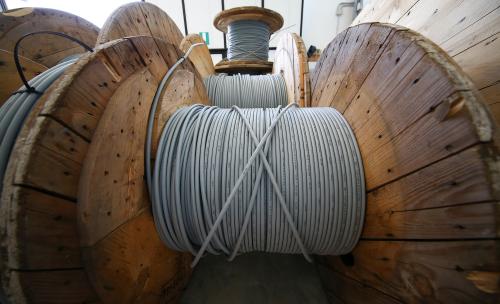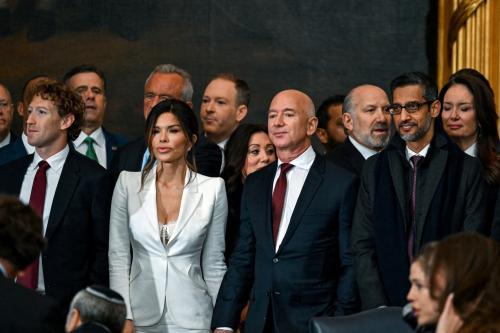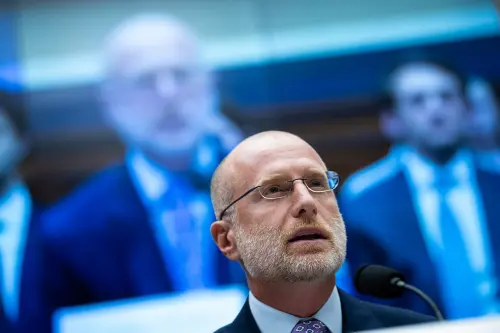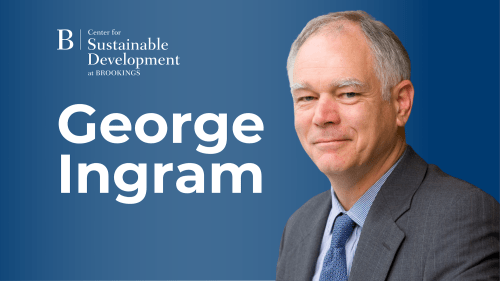After four years of “unbuilding” by the Trump FCC, the new Biden Federal Communications Commission (FCC) faces significant challenges to Build Back Better. This is one of a series of blog posts addressing a selection of those challenges.
Fewer Americans have the internet in their homes than have indoor plumbing. What to do about this shocking statistic begins with understanding that only 20 percent of Americans are without broadband in their homes because it is unavailable.
The previous Build Back Better with Biden FCC focused on broadband deployment in rural America. The lack of deployment certainly is a serious challenge facing the Biden FCC. The digital divide and internet equity, however, is more about consumer adoption than it is about network deployment.
Incomplete data from the Federal Communications Commission (FCC) leaves a wide gap in the estimates of Americans without internet connections. Census Bureau data suggests that three times as many Americans do not have internet service despite its availability than are without service because it isn’t deployed in their area.
For the last four years, the Trump FCC has talked about closing the digital divide. In a slickly produced webpage, Trump FCC Chairman Ajit Pai proclaimed that his “number one priority” has been “to bring the benefits of the internet to all Americans.” The actions of the Trump FCC, however, have been more focused on internet deployment in rural red states than addressing the challenges that diminish internet adoption in blue urban areas.
The previous blog post observed that the Biden FCC will inherit a two-part broadband challenge: an accessibility gap largely in rural areas, and an adoption gap that is more prevalent in urban areas. This paper addresses the adoption problem, how it has been exacerbated by the Trump FCC, and how the Biden FCC will be called upon to think anew and reprioritize in order to connect more Americans.
UNPRECEDENTED TIMES DRIVE UNPRECEDENTED DEMAND
The coronavirus pandemic has put a spotlight on the importance of the internet. Over half of all Americans report that “the internet has been essential during the COVID-19 outbreak.” Imagine how different the COVID-19 pandemic experience would have been for our nation if it had hit in 2003 (at the time of the SARS outbreak) when about one-third of American homes had broadband with a median download speed that is not even enough for a group Zoom session. Thank goodness that if COVID-19 had to happen, it was in 2021 when the world is more connected than ever.
Yet at a time when internet access is proving essential, it is unavailable for too many. Consider:
- The urban connection problem is one of income more than availability;
- Forty percent of U.S. seniors lack sufficient broadband at a time when telehealth has become an ever more important medical tool, safe shopping means online shopping, and social interaction is confined to video services;
- Almost 10 million students – half of which are students of color – do not have the home internet services necessary for remote learning during COVID-19;
- Signing up for a COVID-19 vaccination is an example of an essential online activity and the inability to get online can mean inability to sign up for and schedule a vaccination.
For too many Americans those connections may be physically available but are fiscally unaffordable. A study form the Benton Foundation found low-income Americans can afford around $10 per month for an internet connection but the average broadband subscription costs around $60 per month. As essential as it may be, the internet still sits behind other household priorities such as food, shelter, heat, light, and water.
TRUMP FCC WEAKENS REAGAN-ERA LOW-INCOME SUPPORT PROGRAM
In 1985, during the Reagan administration, the Republican-led FCC created the Lifeline program. The program’s purpose was “to make communications services more affordable for low-income consumers” through a $9.25 monthly subsidy that could be used to lower the cost of telephone service. In 2005, during the George W. Bush administration, the program was expanded to support mobile phones. In 2016, the Obama FCC expanded the program’s scope to allow the $9.25 subsidy to be applied to internet service provided as part of a mobile phone service.
While the Trump FCC channeled billions to telephone companies and other corporations in an attempt to close the digital deployment gap, they quietly and systematically (and “gleefully” in the words of one advocate) slowed the Lifeline program’s efforts to help low-income Americans. As one filing at the FCC described it, “the Commission and Chairman Pai in particular seem dead-set on making Lifeline support even more difficult to obtain for our nation’s low-income people.”
- Early in the Trump FCC, Chairman Pai proposed “improving” service to low-income Americans by eliminating support for the majority of the companies that had been providing mobile Lifeline services. It was a classic example of Trumpian doublespeak that cut support while arguing it was actually “helping” those the Commission was supposed to aid. The spin was that the change would force facility-based companies to build in low-income areas. The reality was that those networks had already been built and were being used by the companies the Trump FCC proposed to eliminate. Fortunately, the effort failed, but it revealed a great deal about the Trump FCC’s thinking.
- Knowing full well that the net neutrality reclassification of internet service providers (ISPs) would undercut the legal authority to support broadband services, the Trump FCC boldly asserted, “the benefits of reclassification [to no longer be common carriers and thus outside the scope of the FCC’s jurisdiction] would outweigh the removal of broadband internet access service from the Lifeline program.” The spin over substance in that statement was spotted by the appeals court that reviewed the net neutrality decision which spotlighted the contradiction and sent the issue back to the commission to fix the problem. The Trump FCC did nothing in response to that remand.
- While many consumers receive a “free” mobile phone when they sign up that is paid for through their monthly bill, the Trump FCC prohibited that incentive for low-income Lifeline participants, thus increasing up front participation costs.
- Then, on the way out the door and without a vote by the Commission, the Chairman increased by 50 percent the minimum amount of data a mobile carrier had to provide to receive Lifeline support. While on the surface this may seem to be good, it had the effect of raising to an unaffordable level the costs of the companies on which Lifeline consumers relied for limited mobile internet access. “Most people will either be cut off or receive … just voice,” one Lifeline carrier CEO explained.
“38 million low-income Americans qualify for Lifeline. Under the Trump FCC participation fell from 32 percent at the end of the Obama FCC to 18 percent under the Trump FCC.”
The number of Lifeline subscribers declined from 12.7 million in 2016 under the Obama FCC to 7.3 million in June 2020. The result of the Trump FCC’s quiet dismantling of the Lifeline program speaks for itself:
- The amount spent to support broadband Lifeline access fell from $1.5 billion in 2016 to $981 million in 2020.
- 38 million low-income Americans qualify for Lifeline. Under the Trump FCC participation fell from 32 percent at the end of the Obama FCC to 18 percent under the Trump FCC.
ONLINE LEARNING IN COVID TIMES
Of the 55 million students enrolled in K-12, 9.7 million students cannot go online for their classes during COVID-19 because their homes do not have a reliable, high-speed internet connection. A Pew Research study found only 17 percent of that number lacked broadband because they couldn’t get it. This suggests that over eight million American students are not able to go to school from their homes during COVID because their homes do not connect to the broadband signal outside their door.
The FCC has a program, called E-Rate, that provides subsidies to schools and libraries to connect them to the internet. As a result of reforms during the Obama era, 99 percent of schools now have high-speed internet connections. There exists a surplus in E-Rate funds. By one estimate that surplus approaches $2 billion.
In the midst of a national crisis that forced American students to stay home and attend school via online classes, the Trump FCC turned its back on the almost 10 million students for whom there was no home internet connection. The “classroom” was now the living room, millions of students could not go to class, however, because their “classroom” was not connected. The broadband providers, working with the non-profit Education Superhighway, stepped up to offer lower cost service to students without internet at home. But it still had to be paid for. School districts and cities were forced to stretch their already tight budgets to find the funds while the Trump FCC refused to help.
A few paragraphs earlier we discussed how the FCC Chairman—on his own authority, without a vote of the Commission—damaged the availability of Lifeline-supported mobile internet service. Such an action is an example of the substantial power of the Chairman. It was a discretionary authority Trump FCC Chairman Pai refused to exercise to help connect low-income American students.
GET SERIOUS ABOUT BROADBAND ADOPTION
To be eligible for the Lifeline program consumers must either have an income at or below 135 percent of the federal poverty level or participate in other federal support programs such as SNAP (food stamps), Medicaid, or SSI. There are 38 million Americans who meet these criteria.
As has been described, the Trump FCC systematically and stealthily worked to weaken the Lifeline program. The Biden FCC’s Build Back Better opportunity for broadband access for low-income Americans has multiple opportunities to reverse that neglect.
Reform Lifeline
Lifeline was never intended to be a program to support broadband. Originally designed so that everyone could call 9-1-1, the program morphed as new technologies came along. Lifeline is insufficient for today’s needs, however, because it is built on telephone era concepts.
“Lifeline is insufficient for today’s needs, however, because it is built on telephone era concepts.”
One of those concepts is that the subsidies can only go to an “Eligible Telecommunications Carrier” (ETC). This was logical at the time the program was developed, since it was for telephone service provided at that time only by telecommunications carriers. The definition was broad enough, however, that when mobile phones came along, they too were covered since they were, after all, “phones.” The introduction of the smartphone began to stress the definitional underpinnings of the program. Clearly, smartphones were “phones,” but they were also capable of accessing the internet and thus, the Obama FCC rationalized, the program should support smartphone internet access.
Today 37 percent of low-income Americans get their internet access on a smartphone. But it is internet service of limited quality. The average throughput of a 4G LTE mobile network is around 17 megabits per second (mbps) at a time when 80 percent of U.S. households can receive service of 1 gigabit (GB) per second – almost 60 times faster. Further limiting Lifeline subscribers’ internet access is how the amount of wireless data they can use each month is capped.
Therein lies the trap of the old program. The largest providers of gigabit service are cable companies. As a vestige of when cable television and telecommunications were different worlds, the cable companies are not typically ETCs. This means, for instance, when a company like Comcast responsibly offers its “Internet Essentials” program of 50 mbps into the home and 5 mbps out for $9.95 per month, it is not eligible for Lifeline support because it does not qualify as an ETC.
The Lifeline program should revert to what it was designed to be: support for low-cost telephone service. A new program should be created for broadband support that is built on 21st century internet realities—and that program should provide meaningful broadband service, not just meet the outdated FCC minimum definition.
Congress, in the December COVID relief law, took the first step toward a meaningful broadband support program. Recognizing the importance of broadband during the pandemic, the law established an Emergency Broadband Relief Fund of $3.2 billion to be administered by the FCC. These funds will pay for a monthly discount on broadband service of up to $50 per month ($75 on tribal lands). The legislation also resolved the ETC problem by allowing cable broadband participation.
Congress gave the FCC only a few weeks to come up with an implementation plan. That plan would be the first step in a Build Back Better policy to overhaul the Lifeline program to help low-income Americans access the most important network of the 21st century.
“A new program should should be created for broadband support that is built on 21st century internet realities—and that program provide meaningful broadband service, not just meet the outdated FCC minimum definition.”
Increase Lifeline Enrollment
Anyone eligible for low-income food assistance (SNAP) is also eligible for Lifeline; yet fewer than one-in-five SNAP participants receive Lifeline benefits.
The Trump FCC discouraged Lifeline participation. For instance, the Trump FCC did little to remediate the catch-22 created by expecting online signup for Lifeline from individuals who did not have online access.
The Biden FCC must reverse the Trump FCC’s neglect of the broadband challenges of low-income Americans. This can begin with an aggressive outreach program, including coordination with other government programs such as SNAP.
SUPPORT ONLINE EDUCATION EVERYWHERE
One of the few federal programs the Trump FCC failed to damage was the E-Rate program supporting broadband connections for schools and libraries. As a commissioner in the Obama FCC, Trump FCC Chairman Pai opposed the expansion and reform of the E-Rate program. Perhaps the embrace of those reforms by Republican state governors inoculated the program from the kind of axe the Trump FCC delivered to the Lifeline program.
But, as mentioned previously, the Trump FCC failed to exhibit any leadership as education moved online from brick-and-mortar buildings. The classroom is no longer in the school building. E-Rate funds that are available for connecting classrooms should be made available to help low-income students pay for access to their new classroom.
Acting FCC Chair Jessica Rosenworcel has already started to correct the Trump FCC’s failure to act, seeking public comment on expanding E-Rate to pay for home connectivity during the crisis. There is no such thing as “too soon” on this important matter.
“One of the tools essential to moving from resilience to rebound is affordable access to the internet.”
ENCOURAGE INTERNET USAGE
For some Americans, their lack internet-use is less about price and more about their lack of internet skills, fear, or unawareness about the internet.
Twenty-three percent of adult Americans have a low level of digital readiness, according to one study. It is, of course, a chicken-and-egg problem. Those who lack sufficient internet access exhibit lower usage skills; and those with lower digital skills exhibit far less internet usage.
Comcast’s “Internet Essentials” program includes free digital literacy training. It is a wise and responsible initiative that confirms how understanding and usage are tied—and should be informative to the Biden FCC.
Another way forward was demonstrated by Congress’ Emergency Broadbands Benefit Program which provides up to $100 for a one-time, one per household, reimbursement for the purchase of a connected device.
INVEST IN RESILIENCE
Given the tools, Americans have demonstrated tremendous resilience during the COVID-19 pandemic. One of the tools essential to moving from resilience to rebound is affordable access to the internet.
As the Biden FCC Builds Back Better and tackles the digital divide as something more than a slogan, a wholistic solution will be required. Deployment of networks in unserved areas; subsidization of subscriptions and equipment; together with education efforts to promote internet literacy will all be necessary to make the promise of the internet manifest to all Americans.
The Brookings Institution is committed to quality, independence, and impact.
We are supported by a diverse array of funders. In line with our values and policies, each Brookings publication represents the sole views of its author(s).






Commentary
Boosting broadband adoption
Part 3 of Build Back Better with Biden FCC
February 11, 2021